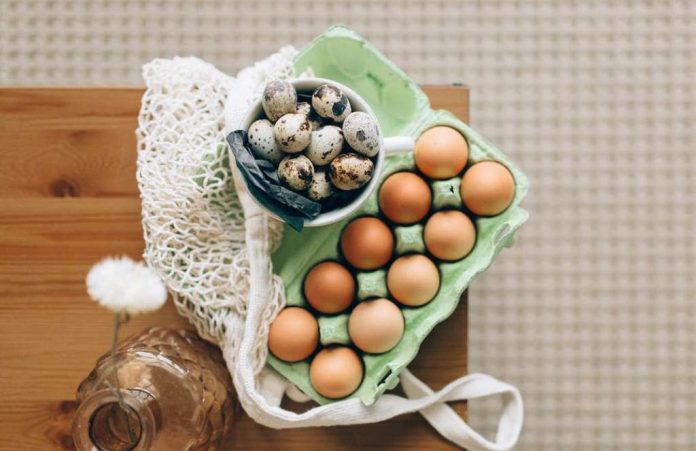You can discover 10 surprising facts about quail eggs, especially if you compare them with chicken eggs.
Due to their smaller size, quail eggs are often used in appetizers, hors d’oeuvres, and as garnishes for various dishes. They are commonly pickled, used in salads, incorporated into sushi, or served as an elegant accompaniment to other foods.
Chicken eggs, on the other hand, are more versatile and commonly used in a wide range of culinary applications, including baking.
Both chicken eggs and quail eggs offer their unique qualities and can be enjoyed in various dishes depending on personal taste and cultural traditions.
 1
1
Denser nutritionally
Quail eggs are packed with essential nutrients, including high-quality protein, vitamins, minerals, and beneficial fatty acids. They offer a concentrated source of nutrients, making them a valuable addition to a well-rounded diet. Even though quail eggs and chicken eggs have similar nutritional profiles, quail eggs are much denser nutritionally than chicken eggs.
- Protein: Quail eggs contain more protein per gram compared to chicken eggs. Protein is essential for building and repairing tissues, and both types of eggs provide high-quality protein.
- Vitamins B12: Quail eggs are known to have higher amounts of certain vitamins and minerals compared to chicken eggs. They are particularly rich in vitamin B12, which is important for nerve function and the production of red blood cells.
- Minerals: Quail eggs also tend to contain higher levels of iron and zinc.
- Cholesterol: Quail eggs and chicken eggs contain similar amounts of cholesterol per gram.
- Choline: Quail eggs are very rich in choline, which promotes fast cell regeneration. It has an excellent lifting (tightening) and smoothing effect, rejuvenating the skin and saving it from wrinkles.
 2
2
Higher yolk-to-white ratio
Quail eggs have a much higher yolk-to-white ratio. If you look at a fried quail egg, you’ll see the big, yellow yolk center and a small white rim around it.
 3
3
Free from bacteria
Unlike chicken eggs, quail eggs can be eaten raw without fear of contracting salmonellosis. There are two reasons for that:
- quails have a higher body temperature than chicken
- quail eggs are resistant to germs since they contain more lysozyme which is effective in killing bacteria
 4
4
Japan has the widest variety of quail eggs dishes
In Japan, quail eggs are prepared in the world’s widest variety of different ways. They can be eaten raw or cooked and often found in bento lunches and sushi. Quail eggs are common ingredients in street food: street vendors sell them kushikatsu-style on skewers or as part of tako tamago, a candy-glazed whole baby octopus with a whole quail egg stuffed inside its head. In Japanese pubs, they can be served soy and mirin-marinated as nibbles with cocktails and beer. In Japan, quail eggs have even become an object of the state policy: schools children are offered 2 quail eggs at lunch.
 5
5
Small size and weight
Quail eggs are significantly smaller than chicken eggs. On average, a quail egg measures about 1/5 the size of a chicken egg. A quail egg weighs 10g compared to a chicken egg that weighs 60g.
 6
6
Better choice for DIY hair and skincare
Every time you have quail eggs in your fridge, don’t miss the opportunity to use them for the benefit of your skin and hair. Persian beauties and Japanese geishas use quail eggs not only in their diet, but also in their beauty care routine as one of the most effective ways of skin rejuvenation. Actually, in a matter of minutes, one quail egg as a face mask can create a miracle that no expensive cream is capable of.
Quail eggs can be used in DIY homemade cosmetics to create nourishing and beneficial beauty products. Lots of facial masks and hair treatments contain quail egg as a major ingredient to get clear complexions, treat acne, tighten loose skin, and make your hair gorgeous.
 7
7
Main ingredient of Scheherazade’s cosmetic mask
This mask is called the mask of eternal youth or the mask of Scheherazade, because, according to legend, it was the eldest daughter of the vizier of King Shahriyar who invented it, and she helped her maintain her youth and beauty for many years. The mask has been very popular among oriental beauties for centuries. Her secret is quail eggs. It is on their basis that this magical rejuvenating mask is made. It acts so gently and intensively on the skin that it does not allow wrinkles to form, and if they already exist make them less deep.
 8
8
“Marble” shell
Quail eggs have a harder shell compared to chicken eggs. Their shells are speckled and often have a different coloration, usually a mix of brown, white, and blue shades.
 9
9
Distinct flavor and taste
Quail eggs have a distinct flavor compared to chicken eggs. They are known to have a richer and more pronounced flavor with a slightly gamey or earthy undertone. Some people also describe quail eggs as being creamier and having a more delicate texture.
 10
10
Portion size
Quail eggs are 3-5 times smaller than chicken eggs but significantly richer in nutrients, so to achieve the equivalent nutritional content of a larger chicken egg, you need only a couple of tiny quail eggs. That can help with weight management and to reduce cholesterol intake. Consider the portion size and adjust your consumption accordingly.


















